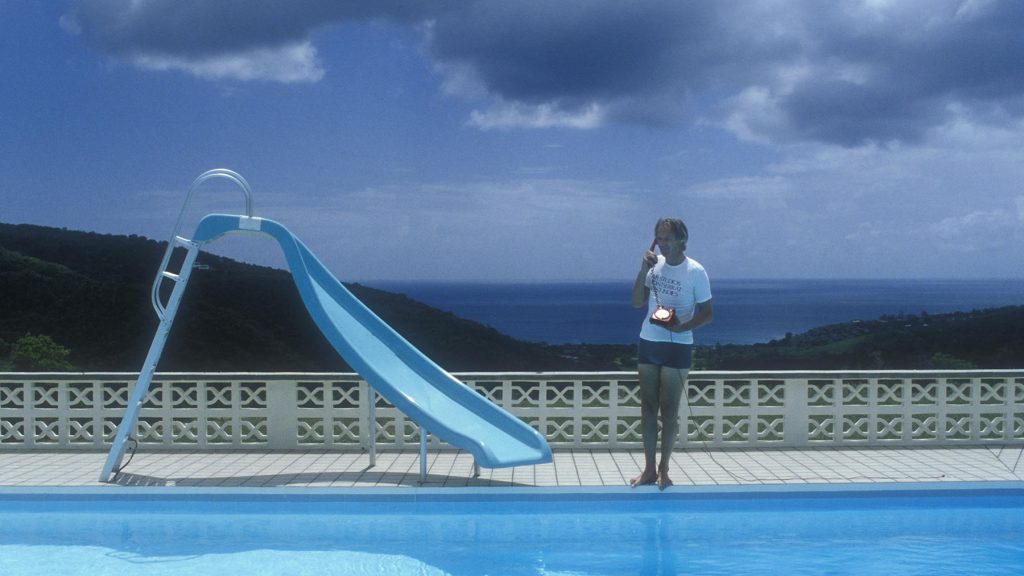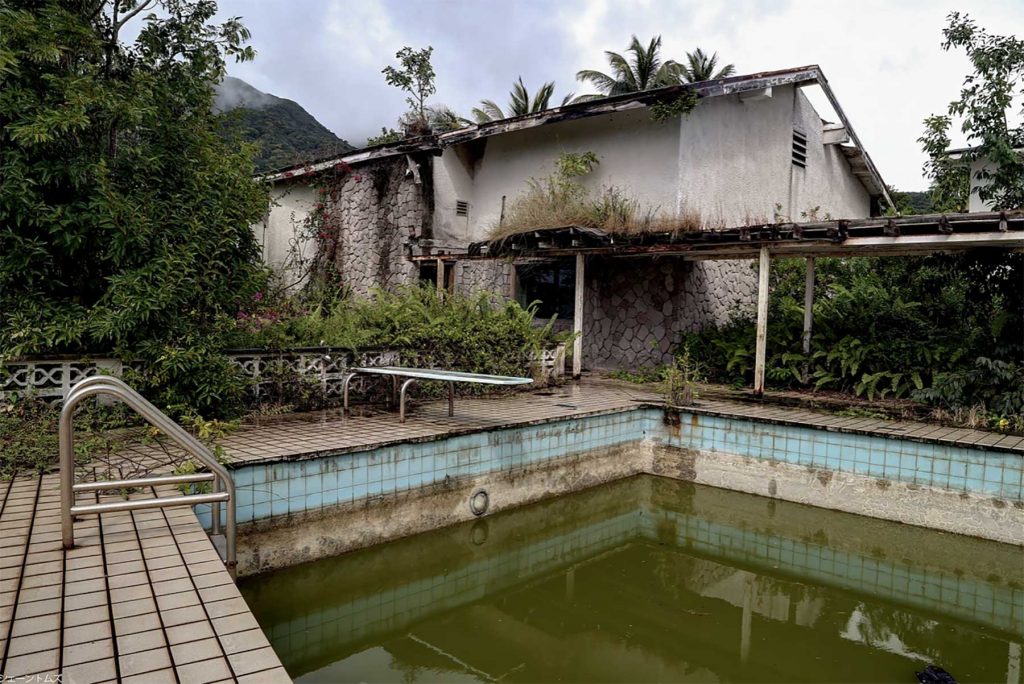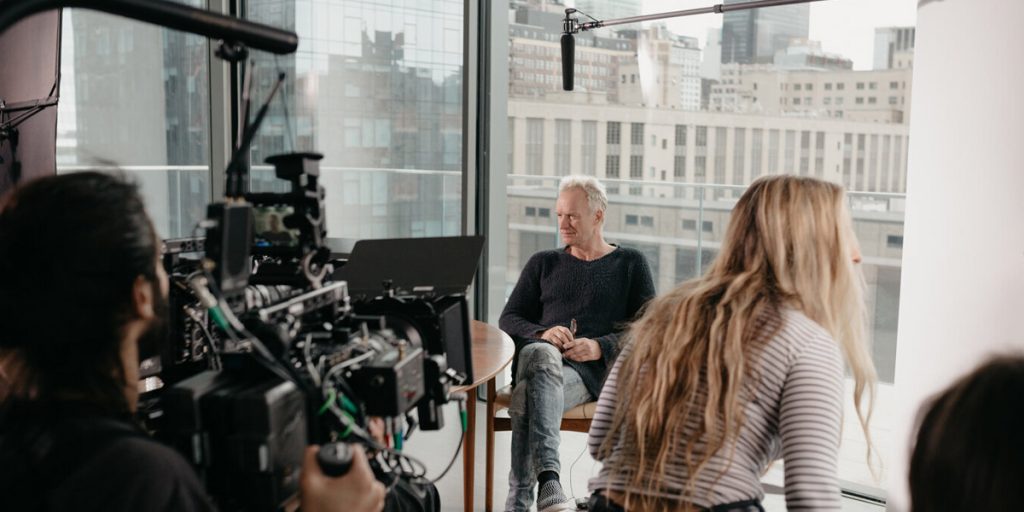Clearly made for the fans, Under The Volcano features many influential recording artists reminiscing about their time at Sir George Martin‘s AIR Studios Montserrat.
If you’re a fan of The Police, Dire Straits, Duran Duran, Ultravox, Elton John, Earth, Wind & Fire, and the many well-known recording artists featured in Under The Volcano, you’ll definitely enjoy Gracie Otto’s (The Last Impresario) documentary. Recently screened at SXSW 2021 as one of the festival’s World Premieres, Under The Volcano sets off to explore the history of AIR Studios Montserrat, a state-of-the-art recording facility located on a remote Caribbean island, under the shadow of an active volcano, and built by Beatles’ producer Sir George Martin, who visited the island after the band split up, fell in love with it, and “bought a place, simple as that”.
Under The Volcano focuses on the decade that saw AIR Montserrat open its doors to many recording artists that defined the era, and brings plenty of nostalgic vibes by balancing heartwarming anecdotes — recounted by the many recording artists, producers, sound engineers, and studio managers, technicians and employees that appear in the film, as well as George Martin’s son — with never-before-seen footage, such as home videos taken by the artists, history-making music videos and live recordings.
Many are the influential musicians that “took over the studio” (as Ultravox’s Midge Ure puts it) from 1979 to 1989, and, watching Under The Volcano, it often feels like you’re listening to a group of friends reminisce about their past. All these musicians seem to share a reverential, almost spiritual love for the facility that saw them record some of their most well-known tracks, so much so that Montserrat almost immediately assumes the quality of a mystical, utopic entity.
“Going to Montserrat was like going into a dream”, says Mark Knopfler as ethereal music accompanies an aerial view of the island, at the beginning of the film. Soon, Sting introduces the “idea of wilderness on the edge of civilization”, with the volcano acting as a “presiding spirit” over an island that musician Jimmy Buffett calls an “arena of creativity”. “This little island had a heart that you could feel”, says Midge Ure, explaining that recording there was like being on “a timewalk”. Duran Duran’s Nick Rhodes describes George Martin’s vision as “a glorious dream”, and Martin’s son talks about his father as a “mad visionary who liked pushing boundaries”, a concept reinforced by Spike Milligan, who recollects Martin’s collaboration with the Beatles as “good Pythonesque British crazy”.

All the artists and personalities featured in the documentary genuinely seem to have had a great time at AIR Montserrat, and this helps the film convey a very specific atmosphere, reinforced by the footage shown throughout and by songs that are bound to strike a chord in many viewers who lived through the era. There’s some real warmth that comes through in some of the artists’ accounts, reinforcing the idea of a mutual collaboration between the musicians and the islanders who happened to cross paths at the studio. Earth, Wind & Fire‘s Verdine White explains that the AIR Montserrat’s housekeeper, Minetta Allen Francis, often ended up being in the band, as the artists would take over the entire building with all its facilities when they recorded there, so “it all kind of overlapped”. Lloyd Oliver and Desmond Riley, from AIR Montserrat’s management, take pride in the fact that they often did backing vocals for The Police, and studio manager Steve Jackson remembers with affection that one of Earth, Wind & Fire’s songs took its title from a Montserrat driver who used to say the same exact words whenever he wanted to talk.
Thanks to many interviews with the actual recording artists who produced these songs at the studio, the documentary also features plenty of heartwarming, undeniably cool clips, such as Sting and The Police dancing and having fun, or Elton John being silly, throwing albums in the swimming pool, and pulling faces while singing some of his most famous songs, as well genuinely interesting anecdotes that are bound to make you smile. My personal favourite is The Police’s Stewart Copeland’s description of their “main songwriter”‘s tendency to “not reveal their songs until [they] needed them”, and his account of how “Every Little Thing She Does Is Magic” was recorded, one morning, from a demo that Sting had made by himself, and made it to the record in one taping.
Under The Volcano shines in these anecdotes, as they give us genuine insight into the lives of some of the world’s most famous recording artists, accompanied by footage and songs that we’ve never seen before. However, when the documentary moves away from the artists and shifts its focus onto the island, insisting on its dream-like, mystical connotations, it often alienates that part of the audience that would have been more interested in the history of the studio, rather than the possibilities it brought to a very select few.

In fact, AIR Montserrat didn’t just make history for the 76 albums recorded there — among which, The Police’s “Ghost in the Machine” and “Synchronicity”, Elton John’s “Too Low for Zero”, and The Rolling Stones’ “Steel Wheels” — but also, and above all, because it was struck by tragedy twice, first in 1989 when Hurricane Hugo hit the island, leaving 11,000 (out of 12,000) islanders without a home, then in 1995, when the Soufrière Hills volcano unexpectedly erupted, rendering more than half of the island inhabitabile and taking the lives of 19 people. Regrettably, the issue is barely explored in the film: “It’s Atlantis, now, isn’t it?”, says Duran Duran’s Nick Rhodes, while Ray Cooper talks about “magical moments [that are] going to be no longer”, and Sting recalls how sad it was to fly over the “ghost town”, after the eruption, because he has so many memories of the place.
Barely any time is spent on the huge impact both tragedies had on the islanders, and this makes it hard to concentrate on how it affected all the recording artists who, unlike Montserrat’s inhabitants, were able to leave the island and go back to their own lives. Even more irritating are the insensitive remarks on colonialism made during the film by more than one interviewee: for instance, AIR Montserrat studio manager Yve Robinson states that the island’s “magic” comes from the fact that “once, it was colonized by the Irish, and that’s why the island is so different, cause it’s just a really friendly place”, while musician Jimmy Buffett recalls that the American bands didn’t like having to pay for each drink separately at the bar, in adherence to the island’s customs, and that he solved the issue by deciding to “just buy the whole f*ing bar”.
As the camera pans and shows us what the destroyed island looks like now, with a series of images and footage reminiscent of the opening scenes of James Cameron’s Titanic, it’s hard to be able to focus on the well-meaning — though also privileged — figures explored by the documentary without wondering about the side we don’t get to hear, such as that of the 11,0000 Montserrat residents who lost their homes, or of the eruption’s victims and their relatives and friends. This makes Under The Volcano quite a contradiction: is Otto’s documentary a heartwarming throwback to a specific time in music history, or is it an exploration of tragedy that fails to give a voice to the individuals, and the communities, who were directly affected by it? In a way, it’s neither, but it’s also both.

Though Under The Volcano succeeds at representing a specific slice of music history and taking us back to the 1980s with never-before-seen footage and compelling tales, it cannot be denied that there’s much more to AIR Montserrat, and to the island, than what is shown in the film. So, watch the documentary for the unseen audio-visual material and the heartwarming insight into your favourite artists’ lives, and get ready to be taken back in time in the best possible way, but with the knowledge that there’s more to Montserrat’s history than what’s shown in the film.
Under the Volcano premiered at SXSW Online on March 20, 2021.

